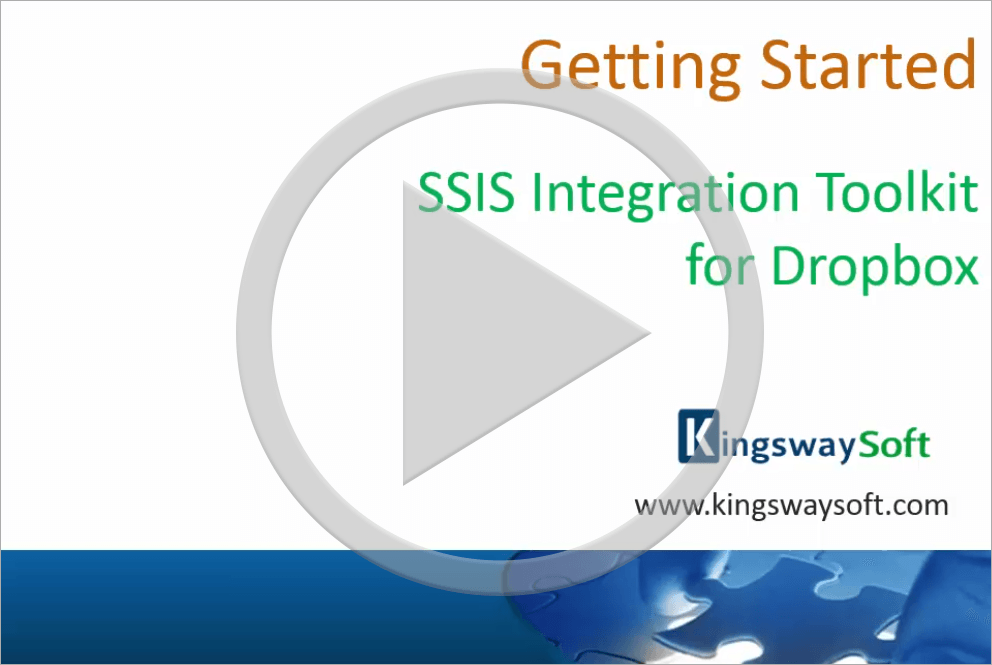Installation
To install and run SSIS Integration Toolkit for Dropbox, your system must have the following components installed.
- A supported SSIS design-time or run-time, which can be one of the following:
- SSIS 2016
- SSIS 2014
- SSIS 2012
- SSIS 2008 R2
- SSIS 2008
- SSIS 2005
For SSIS runtime, the installation should be done by using the corresponding SQL Server installation media (most likely in CD/DVD format), and you must select the "Integration Services" component during the installation (as shown below).
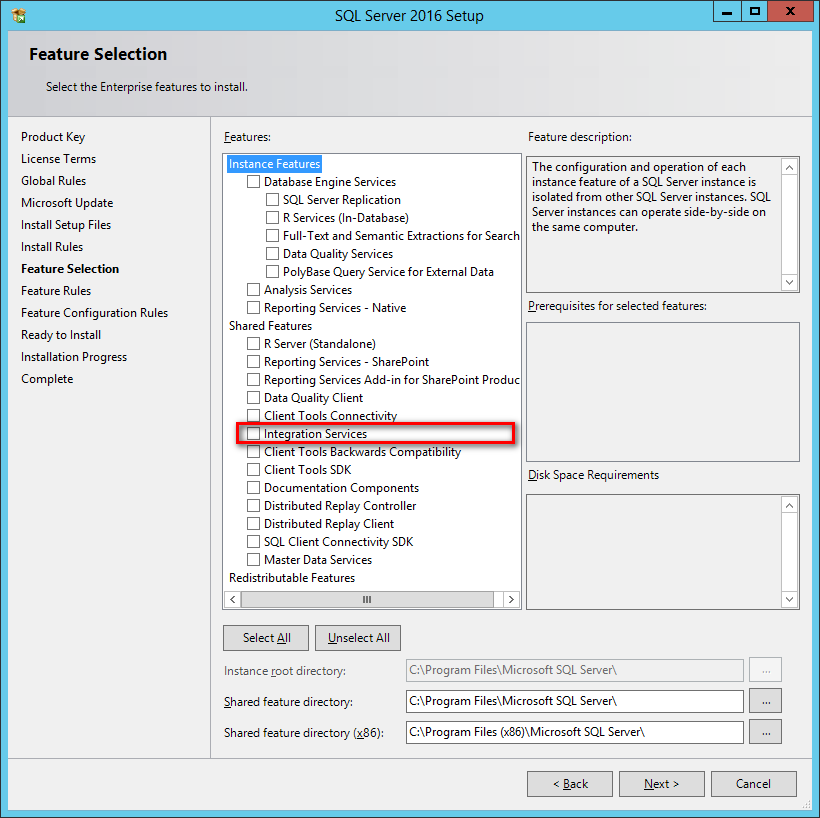
Note that for SSIS runtime, SQL Server Standard Edition or above is required to run our software. SQL Server Express or Web editions are not supported due to their own limitations.
Note that when using SQL Server 2014, a cumulative update is required (a recent service pack, such as one of the following, is more preferred) in order to run our software during runtime.
- SQL Server 2014 Service Pack 2: https://www.microsoft.com/download/details.aspx?id=53168
- SQL Server 2014 Service Pack 1: https://www.microsoft.com/download/details.aspx?id=46694
For SSIS design-time, you should be installing the version of SSDT (SQL Server Data Tools) or BIDS (Business Intelligence Development Studio) that aligns with the SQL Server version that you plan to use for your final deployment (the runtime).
- When targeting SSIS 2016, you would use SSDT for Visual Studio 2015 available for download at
https://msdn.microsoft.com/mt186501.aspx
- Note that this SSDT installation can be used to target SSIS 2014 or 2012 as well.
- When targeting SSIS 2014, you can use either one of the following:
- SSDT for Visual Studio 2015: https://msdn.microsoft.com/mt186501.aspx (Packages created using SSDT 2015 need to have their project's TargetServerVersion setting set to "SQL Server 2014" in order to work with SSIS 2014)
- SSDT-BI for Visual Studio 2013: https://www.microsoft.com/download/details.aspx?id=42313
- When targeting SSIS 2012, you can use any one of the following:
- SSDT for Visual Studio 2015: https://msdn.microsoft.com/mt186501.aspx (Packages created using SSDT 2015 need to have their project's TargetServerVersion setting set to "SQL Server 2012" in order to work with SSIS 2012)
- SSDT-BI for Visual Studio 2012: https://www.microsoft.com/download/details.aspx?id=36843
- You can install the "SQL Server Data Tools" component that is shipped with the SQL Server 2012 installation media (which is based on a Visual Studio 2010 shell)
- When targeting SSIS 2008 R2 or earlier, you would have to install the Business Intelligence Development Studio that is shipped with the installation media of the corresponding SQL Server version.
-
.NET Framework 3.5
- For any version before v1.1, .NET Framework 3.5 is required.
For v1.1 or later, .NET Framework 3.5 is only required when you use SSIS 2005.
- If you are using Windows Server 2003, Windows Server 2008, Windows Vista, Windows XP operating systems, you would install .NET framework by downloading it from Microsoft website.
- If you are using Windows Server 2008 R2 or 2012 family of operating systems, .NET framework 3.5 should be installed using Server Manager program by adding .NET Framework 3.5.1 features.
- If you are using Windows 8, go to Control Panel -> Programs and Features -> Turn Windows features on or off, then select .NET Framework (includes .NET 2.0 and 3.0).
- For any version before v1.1, .NET Framework 3.5 is required.
For v1.1 or later, .NET Framework 3.5 is only required when you use SSIS 2005.
- Windows Installer 4.5
- If you are using Windows Server 2008, Windows Server 2012 family of operating systems or later (including Windows Vista, Windows 7, Windows 8, Windows Server 2012 R2, Windows Server 2016), you do not need to do anything since the latest Windows Installer has been installed by the operating system.
- If you are using Windows Server 2003 family of operating systems (including Windows XP), you should install Windows Installer 4.5 by downloading it from Microsoft website.
When you have confirmed that your system satisfies the above prerequisites, you can navigate to the KingswaySoft website at http://www.kingswaysoft.com to download the installation package. In the download page you will find two download links: one for x86 systems and one for x64 systems. Make sure to choose and download the correct package for your system.

After you have downloaded the package, you can install the software by following the installation wizard.
Using the Dropbox Connection Manager
The Dropbox Connection Manager is an SSIS connection manager component that can be used to establish connections with Dropbox.
To add a Dropbox connection to your SSIS package, right-click the Connection Manager area in your Visual Studio project, and choose "New Connection..." from the context menu. You will be prompted the "Add SSIS Connection Manager" window. Select the "Dropbox" item to add the new Dropbox connection manager.
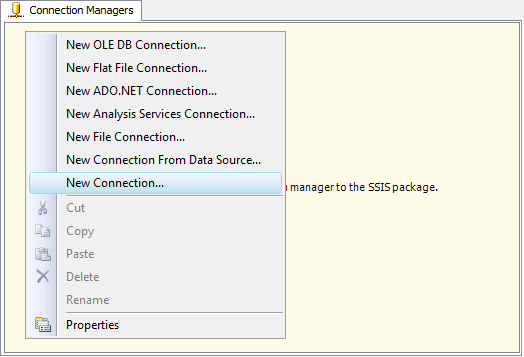

The Dropbox Connection Manager contains the following three pages which configures how you want to connect to Dropbox.
- General
- Advanced Settings
- More Info
General page
The General page on the Dropbox Connection Manager allows you to specify general settings for the connection. Before you can connect to Dropbox, you must first create a Custom Service.
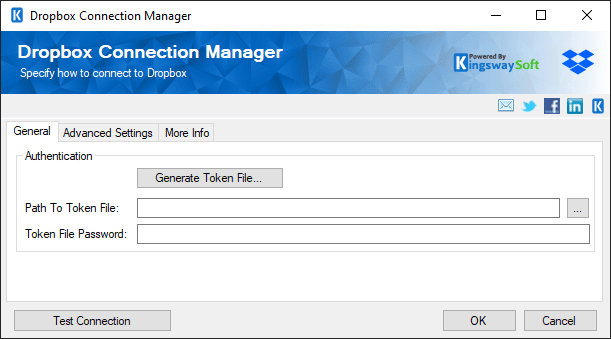
- Account Id
-
The Account Id field is automatically received from Dropbox after you click the Edit Account Information button and complete the OAuth sign in procedure.
- Account Name
-
The Account Name field is automatically received from Dropbox after you click the Edit Account Information button and complete the OAuth sign in procedure. This field is not stored anywhere and is only to help you know what account this connection is associated with.
- Edit Account Information
-
The Edit Account Information button initiates the OAuth Sign In Procedure.
- Timeout (secs)
-
The Timeout (secs) option allows you to specify a timeout value in seconds for the connection. The default value is 120 seconds.
- Retry on Intermittent Errors
-
This is an option designed to help recover from possible intermittent outages or disruption of service so the integration does not have to be stopped because of such temporary issues. Enabling this option will allow service calls to be retried upon certain types of failure. A service call may be retried up to 3 times before an exception is fired. Retries occur after 0 seconds, 15 seconds, and 60 seconds. Warning: although we have carefully designed this feature so that such retries should only happen when it is deemed to be safe to do so, in some extreme occasions, such retried service calls could result in the creation of duplicate data.
- Show Access Token
-
After completing the OAuth sign in procedure, the Connection Manager receives an Access Token from Dropbox. The Access Token is used to authenticate and gain access to your Dropbox instance through the Dropbox API. The Access Token gets stored as a password field in the connection manager and is only displayed if you click this button. This allows to retreive the Access Token if you chose to store it in a config file instead.
- Test Connection
-
After all the connection information has been provided, you may click the Test Connection button to test if the connection settings entered are valid.
Advanced Settings
The Advanced Settings page on the Dropbox Connection Manager allows you to specify some advanced and optional settings for the connection.

- Proxy Mode
-
Proxy Mode option allows to specify how you want to configure the proxy server setting. There are three options available.
- No Proxy
- Auto-detect (Using system configured proxy)
- Manual
- Proxy Server
-
Using Proxy Server option allows you to specify the name of the proxy server for the connection.
- Port
-
The Port option allows you to specify the port number of the proxy server for the connection.
- Username (Proxy Server Authentication)
-
Username option (under Proxy Server Authentication) allows you to specify the proxy user account.
- Password (Proxy Server Authentication)
-
Password option (under Proxy Server Authentication) allows you to specify the proxy user's password.
NOTE: The Proxy Password is not included in the connection manager's ConnectionString property by default. This is by design for security reasons. However, you can include it in your ConnectionString if you want to parameterize your connection manager. The format would be ProxyPassword=myProxyPassword; (make sure you have a semicolon as the last character). It can be anywhere in the ConnectionString.
More Info page
The More Info page shows some basic information about the toolkit. In this page, you can find the version information of the toolkit.

OAuth Sign In Procedure
The OAuth Sign In Procedure is initiated by clicking the Edit Account Information button on the Connection Manager. What this procedure does is give our application access to your dropbox data without ever knowing your Dropbox credentials. All you need to do is sign into dropbox and then give our app access. After that, Dropbox will give us an Access Token that will be used to access your Dropbox data. Note that if you have a proxy, you will need to fill out the proxy settings in the Advanced Settings page of the Connection Manager before initiating the OAuth Sign In procedure.


Adding SSIS Components to Business Intelligence Development Studio's Toolbox
SSIS Integration Toolkit for Dropbox includes two data flow components for use with Dropbox. They need to be added to the SSIS toolbox before you can use them in a SSIS data flow task.
NOTE: If you are using SQL Server 2012 or later development environment, you should not need to do this, as SQL Server 2012 or later automatically lists all available pipeline components by scanning the system.
To add the data flow components, create a new data flow task if you do not have one yet and switch to the SSIS data flow page. Right-click on the toolbox area to bring up the context menu, where you can select the "Choose Items..." option as shown below.

You will be presented with a window called "Choose Toolbox Items". Switch to "SSIS Data Flow Items" tab, and select Dropbox Destination and Dropbox Source components from the list.

Both data flow components should now appear in your SSIS Toolbox, where you can drag and drop any of them to the design surface of your SSIS data flow task.
Using the Dropbox Source Component
The Dropbox Source Component is an SSIS data flow pipeline component that can be used to read / retrieve data from Dropbox.
The component includes the following two pages to configure how you want to read data from Dropbox.
- General
- Columns
General page
The General page of the Dropbox Source Component allows you to specify the general settings of the component.

- Connection Manager
-
The Dropbox Source Component requires a Dropbox connection in order to connect with Dropbox. The Connection Manager drop-down will show a list of all Dropbox connection managers that are available to your current SSIS package.
- Source Item Path
-
The Source Item Path specifies the base item to point to for retrieval. Click the eclipse button ('...') to open up a Dropbox browser dialog to select an item.
- Item Selection Mode
-
The Item Selection Mode specifies what Dropbox item(s) will get selected. The Files Only modifier will still go through folders to retrieve items but will not return any records for the folders.
- SelectedItem will only retrieve the item specified.
- Recursive will retrieve the selected item (specified in the Source Item Path field) and all sub items.
- Recursive (Files only) will retrieve all files only from the selected item specified and its sub items.
- Selected Level will retrieve the selected item and its items on the folder level selected.
- Selected Level (Files only) will retrieve all files only from the selected item level.
- Refresh Component Button
-
Clicking the Refresh Component button causes the component to retrieve the latest metadata and update each field to its most recent metadata.
Columns page
The Columns page of the Dropbox Source Component shows you all available attributes from the object that you specified on the General page.

On the top left of the grid, you can see a checkbox, which can be used to toggle the selection of all available Dropbox fields. This is a productive way to check or uncheck all available fields.
NOTE: As a general best practice, you should only select the Dropbox fields that are needed for the downstream pipeline components.
Using the Dropbox Destination Component
The Dropbox Destination Component is an SSIS data flow pipeline component that can be used to write data to Dropbox. You can create, delete, move, or upsert objects that allow a particular action with this component. There are three pages of configuration:
- General
- Columns
- Error Handling
The General page is used to specify general settings for the Dropbox Destination Component. The Columns page allows you to map the columns from upstream components to Dropbox fields in the destination object. The Error Handling page allows you to specify how errors should be handled when they occur.
General page
The General page allows you to specify general settings for the component.

- Dropbox Connection Manager
-
The Dropbox Destination Component requires a Dropbox connection. The Dropbox Connection Manager option will show all Dropbox connection managers that have been created in the current SSIS package or project.
- Action
-
The Action option allows you to specify how data should be written to Dropbox. There are currently four (4) supported:
- Create
- Move
- Upsert
- Delete
- Create
- Refresh Component Button
-
Clicking the Refresh Component button causes the component to retrieve the latest metadata and update each attribute to its most recent metadata.
- Map Unmapped Fields Button
-
By clicking this button, the component will try to map any unmapped Dropbox attributes by matching their names with the input columns from upstream components. This is useful when your source component has recently added more columns, in which case you can use this button to automatically establish the association between input columns and unmapped destination attributes.
- Clear All Mappings Button
-
By clicking this button, the component will reset all your mappings in the destination component.
Columns page
The Columns page of the Dropbox Destination Component allows you to map the columns from upstream components to the Dropbox destination fields.
In the Columns page, you would see a grid that contains four columns as shown below.

- Input Column - You can select an input column from an upstream component for the corresponding Dropbox field.
- Dropbox Field - The Dropbox field that you are writing data.
- Data Type - This column indicates the type of value for the current field.
- Unmap - This column can be used to unmap the field from the upstream input column, or otherwise it can be used to map the field to an upstream input column by matching its name if the field is not currently mapped.
Error Handling page
The Error Handling page allows you to specify how errors should be handled when they happen.

There are three options available.
- Fail on error
- Redirect rows to error output
- Ignore error
When the Redirect rows to error output option is selected, rows that failed to write to Dropbox will be redirected to the 'Error Output' output of the Destination Component. As indicated in the screenshot below, the green output connection represent rows that were successfully written, and the red 'Error Output' connection represents rows that were erroneous. The 'ErrorMessage' output column found in the 'Error Output' may contain the error message that was reported by Dropbox or the component itself.

NOTE: Use extra caution when selecting Ignore error option, since the component will remain silent for any errors that have occurred.
Enable Columns for Default Output.
- DropboxItemSize - Contains the size of the Dropbox record
- DropboxItemIsDeleted - Contains boolean
- DropboxItemPath - Contains path of Dropbox record
- DropboxItemIsDirectory - Contains the status of the Dropbox record
Additional Components - Premium File Pack
In addition to the SSIS Components listed above, the following are additional components that come with the toolkit:
- Premium File Pack Source Component
- Premium File Pack Destination Component
- Premium File Transfer Task Component
License Manager
SSIS Integration Toolkit comes with a license manager program which helps you manage and activate the product license key to be used for the toolkit.
Without a commercial license, SSIS Integration Toolkit will operate under the Developer License which is free to use for development or evaluation purpose. Under the developer license, you can use the software within the development tool (SSDT, SSDT-BI, BIDS, or Visual Studio).

The only limitation with the free developer license is the inability to run the software outside of the development tool (SSDT-BI, BIDS, or Visual Studio). If you would like to run the software outside the development tool, such as running SSIS packages on a scheduled basis or from a command line, you will need to acquire a license from us.
If you want to test out the functionality by scheduling your SSIS packages, a trial license can be requested. To do so, you can launch License Manager program, then click "Change License Key" button, where you can request a free trial license after filling out the necessary Licensee Information.
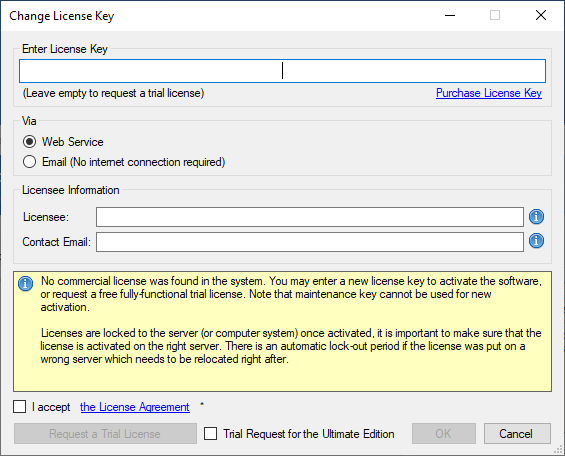
If you have received a product license key from us after placing an order through our online shopping cart system, you can also click "Change License Key" button and enter the product license key in order to activate the software to use the fully-featured commercial license.
To request a free trial license or activate a product license key that you have received, you can use Web Service option to complete the process by sending the request to our license server directly. An Internet connection is required when Web Service option is used. This is the option that we recommend.
Alternatively, you can choose the Email option so that the license manager will generate an email for you which you can send to us. The Email option should only be used if your system has no Internet access. It requires manual processing so please expect to wait for 24 to 48 hours before receiving a license file from us. Once you have received the license file from us from through email, you can save it to a local file, which you can then install by clicking "Install License File..." button in License Manager.
If you have acquired a perpetual license from us, once the software has been activated, your license manager will be shown as something like below.

Since v2.0, you can see your Support Expiry Date or Maintenance Expiry Date in the License Manager program if you are using a perpetual license. By default, your perpetual license comes with a one-year maintenance and upgrade, which entitles you to use any version of the software released before your Support Expiry Date or Maintenance Expiry Date. You can extend it by entering a new maintenance license key that you have acquired from us.
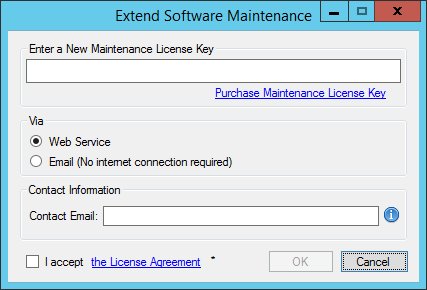
If your commercial license is a subscription license, you will not see the Support Expiry Date or Maintenance Expiry Date option in the License Manager program, since your subscription license comes with maintenance and upgrade for the entire subscription period.
NOTE: You must run License Manager program under a local administrative account due to the privileges required to write license file to the system.
Contact Us
If you need any further assistance with the toolkit, please don't hesitate to contact us.


